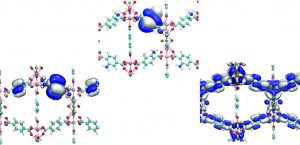G. Capano, F. Ambrosio, S. Kampouri, K. C. Stylianou, A. Pasquarello, and B. Smit, On the Electronic and Optical Properties of Metal-Organic Frameworks: Case Study of MIL-125 and MIL-125-NH2 J Phys Chem C (2020) doi: 10.1021/acs.jpcc.9b09453

Abstract: The photoactive MIL-125 and MIL-125-NH2 Metal-Organic Frameworks (MOFs), despite a very similar crystalline structure, exhibit different optically behaviour. Luminescence in MIL-125 decays in about 1 ns while for its amino counterpart the lifetime of the charge-carriers is at least one order of magnitude larger. The origin of this difference is the key element for understanding the photocatalytic behaviour of MIL-125-NH2 when associated with active nanoparticles, behaviour that is completely absent in MIL-125. By performing advanced ab-initio electronic structure calculations, we find that charge-carriers interact differently in the two MOFs with subsequent effects on the luminescence lifetimes and their catalytic performances. To confirm the predictions of our model we synthesized a novel material in the MIL-125 family, MIL-125-NH2-[10%](OH)2, and confirm that our theory correctly predicts a faster decay compared to MIL-125-NH2.